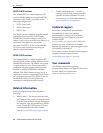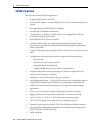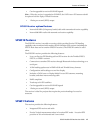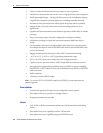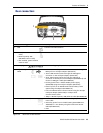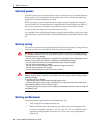
2 Features and Functions
22 SPSx51 Modular GPS Receivers User Guide
• Choice of external GPS antenna for base station or rover operation
• Attached or external radio antenna for rover or high-gain base station operation
• Small, lightweight design – 1.65 kg (3.64 lbs) receiver only, including the battery;
4 kg (8.82 lbs) complete system weight (rover including controller and rod)
• Permanent/semi-permanent and mobile quick setup base station capability
• Backpack, belt, rod, truck, and marine vessel mounting options for rover
applications
• Capable of all site measurement and stakeout operations within radio or cellular
coverage
• Easy-to-use menu system for rapid configuration and status checking
• AutoBase technology for rapid and automated repeated daily base station
setups
• Can broadcast corrections through multiple radio links from one base station,
for example, through an internal 450 MHz radio and an external 900 MHz radio
or over the Internet.
• Rugged, weatherproof construction with an IP67 environmental rating
• –40 °C to +65 °C (–40 °F to +149 °F) operating temperature range
• 9.5 V to 28 V DC input power range, with over-voltage protection
• Capable of rover operation within a VRS (Virtual Reference Station) network
• Moving baseline and heading capability when any SPSx51 receiver (excluding
the SPS551H or SPS751 Basic receiver) is combined with any SPSx51 or SPS551H
Add-on receiver.
• RoHS compliant
• 1 Pulse-per-second (1PPS) output
Note – To receive GPS L5 or GLONASS signals in the SPS851, you must purchase the
optional upgrade.
Base station
• Unrestricted operational range for rovers and grade control systems
• Base station and rover operation in a single receiver
• Integrated transmit/receive radio
Rover
• 5 Hz, 10 Hz, or 20 Hz measurement update rate (10 Hz maximum in Heading
mode)
• Base station-free rover capability within a VRS network
• Base station-free rover capability using OmniSTAR services



